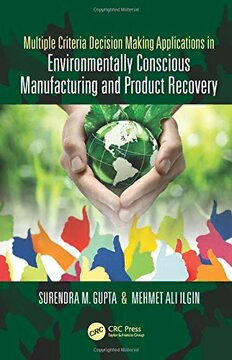
Multiple Criteria Decision Making Applications in Environmentally Conscious Manufacturing and Product Recovery PDF
Preview Multiple Criteria Decision Making Applications in Environmentally Conscious Manufacturing and Product Recovery
Multiple Criteria Decision Making Applications in Environmentally Conscious Manufacturing and Product Recovery Multiple Criteria Decision Making Applications in Environmentally Conscious Manufacturing and Product Recovery By Surendra M. Gupta and Mehmet Ali Ilgin CRC Press Taylor & Francis Group 6000 Broken Sound Parkway NW, Suite 300 Boca Raton, FL 33487-2742 © 2018 by Taylor & Francis Group, LLC CRC Press is an imprint of Taylor & Francis Group, an Informa business No claim to original U.S. Government works Printed on acid-free paper International Standard Book Number-13: 978-1-4987-0065-8 (Hardback) This book contains information obtained from authentic and highly regarded sources. Reasonable efforts have been made to publish reliable data and information, but the author and publisher cannot assume responsibility for the validity of all materials or the consequences of their use. The authors and publishers have attempted to trace the copyright holders of all material reproduced in this publication and apologize to copyright holders if permission to publish in this form has not been obtained. If any copyright material has not been acknowledged please write and let us know so we may rectify in any future reprint. Except as permitted under U.S. Copyright Law, no part of this book may be reprinted, reproduced, transmitted, or utilized in any form by any electronic, mechanical, or other means, now known or hereafter invented, including photocopying, microfilming, and recording, or in any information storage or retrieval system, without written permission from the publishers. For permission to photocopy or use material electronically from this work, please access www.copyright.com (http://www.copyright.com/) or contact the Copyright Clearance Center, Inc. (CCC), 222 Rosewood Drive, Danvers, MA 01923, 978-750-8400. CCC is a not-for-profit organiza- tion that provides licenses and registration for a variety of users. For organizations that have been granted a photocopy license by the CCC, a separate system of payment has been arranged. Trademark Notice: Product or corporate names may be trademarks or registered trademarks, and are used only for identification and explanation without intent to infringe. Visit the Taylor & Francis Web site at http://www.taylorandfrancis.com and the CRC Press Web site at http://www.crcpress.com To Sharda Gupta, Monica Gupta, and Neil Gupta – Surendra M. Gupta Bahar Sarı Ilgı n – Mehmet Ali Ilgin Contents Preface ..................................................................................................................xiii Acknowledgments ................................................................................................xv Authors ................................................................................................................xvii 1. Multiple Criteria Decision Making in Environmentally Conscious Manufacturing and Product Recovery ...................................1 1.1 Introduction ...........................................................................................1 1.2 Quantitative Techniques ......................................................................2 1.2.1 Goal Programming ..................................................................2 1.2.2 Fuzzy Goal Programming ......................................................4 1.2.3 Physical Programming ............................................................5 1.2.3.1 Reverse and Closed-Loop Supply-Chain Network Design .......................................................5 1.2.3.2 Disassembly-to-Order Systems ..............................6 1.2.4 Data Envelopment Analysis ...................................................7 1.2.5 Other Mathematical Models ..................................................7 1.3 Qualitative Techniques.........................................................................8 1.3.1 Analytical Hierarchy Process .................................................8 1.3.2 Fuzzy Analytical Hierarchy Process .....................................9 1.3.3 Analytical Network Process .................................................10 1.3.4 DEMATEL ...............................................................................10 1.3.5 TOPSIS .....................................................................................11 1.3.6 ELECTRE .................................................................................11 1.3.7 PROMETHEE .........................................................................12 1.3.8 Multiattribute Utility Theory (MAUT) ...............................12 1.3.9 VIKOR ......................................................................................12 1.3.10 MACBETH ..............................................................................13 1.3.11 Case-Based Reasoning ..........................................................13 1.3.12 Gray Relational Analysis ......................................................13 1.3.13 Other Techniques ...................................................................14 1.4 Mixed Techniques ...............................................................................14 1.4.1 Analytical Hierarchy Process and Data Envelopment Analysis ...................................................................................14 1.4.2 PROMETHEE and Goal Programming ..............................14 1.4.3 PROMETHEE and Analytical Hierarchy Process .............15 1.4.4 PROMETHEE and Analytical Network Process ...............15 1.4.5 Analytical Hierarchy Process and Case-Based Reasoning ................................................................................15 1.4.6 Analytical Network Process and Goal Programming .....15 vii viii Contents 1.4.7 Analytical Network Process and Data Envelopment Analysis ...................................................................................15 1.4.8 Analytical Hierarchy Process and Genetic Algorithms ...16 1.4.9 Analytical Hierarchy Process and Neural Networks .......16 1.4.10 Analytical Hierarchy Process and Analytical Network Process ....................................................................16 1.4.11 Analytical Hierarchy Process and TOPSIS ........................16 1.4.12 Analytical Network Process and Gray Relational Analysis ...................................................................................16 1.4.13 Analytical Hierarchy Process and Simulation ..................16 1.4.14 Analytical Hierarchy Process and Structural Equation Modeling ................................................................17 1.4.15 Approaches Involving More than Two Techniques ..........17 1.5 Heuristics and Metaheuristics ..........................................................18 1.6 Simulation ............................................................................................19 1.7 Conclusions ..........................................................................................20 References .......................................................................................................21 2. Techniques Used in the Book .....................................................................35 2.1 Goal Programming .............................................................................35 2.2 Fuzzy Logic ..........................................................................................36 2.3 Linear Physical Programming ..........................................................39 2.4 Data Envelopment Analysis ..............................................................41 2.4.1 CCR Model ..............................................................................42 2.4.2 BCC Model ..............................................................................43 2.5 Analytical Hierarchy Process ............................................................44 2.6 Analytic Network Process .................................................................45 2.7 DEMATEL ............................................................................................46 2.8 TOPSIS ..................................................................................................48 2.9 ELECTRE ..............................................................................................49 2.10 PROMETHEE .......................................................................................52 2.11 VIKOR ...................................................................................................54 2.12 MACBETH ...........................................................................................56 2.13 Gray Relational Analysis ...................................................................57 2.14 Simulation ............................................................................................59 2.15 Conclusions ..........................................................................................60 References .......................................................................................................60 3. Goal Programming .......................................................................................63 3.1 The Model ............................................................................................63 3.1.1 Revenues .................................................................................63 3.1.1.1 Reuse Revenue ........................................................63 3.1.1.2 Recycle Revenue .....................................................64 3.1.1.3 New Product Sale Revenue ...................................64 3.1.2 Costs .........................................................................................64 Contents ix 3.1.2.1 Collection/Retrieval Cost......................................64 3.1.2.2 Processing Cost .......................................................64 3.1.2.3 Inventory Cost ........................................................65 3.1.2.4 Transportation Cost ...............................................65 3.1.2.5 Disposal Cost ..........................................................65 3.1.3 System Constraints ................................................................66 3.2 Numerical Example ............................................................................68 3.3 Other Models .......................................................................................69 3.4 Conclusions ..........................................................................................70 References .......................................................................................................70 4. Fuzzy Goal Programming ..........................................................................71 4.1 The Model ............................................................................................71 4.1.1 Revenues .................................................................................72 4.1.1.1 Reuse Revenue ........................................................72 4.1.1.2 Recycle Revenue .....................................................73 4.1.1.3 New Product Sale Revenue ...................................73 4.1.2 Costs .........................................................................................73 4.1.2.1 Collection/Retrieval Cost......................................73 4.1.2.2 Processing Cost .......................................................73 4.1.2.3 Inventory Cost ........................................................74 4.1.2.4 Transportation Cost ...............................................74 4.1.2.5 Disposal Cost ..........................................................75 4.1.3 System Constraints ................................................................75 4.2 Numerical Example ............................................................................77 4.3 Other Models .......................................................................................78 4.4 Conclusions ..........................................................................................79 References .......................................................................................................79 5. Linear Physical Programming ...................................................................81 5.1 The Model ............................................................................................81 5.1.1 Model Formulation ................................................................81 5.1.1.1 Class-1S Criteria (Smaller-Is-Better) ....................81 5.1.1.2 Class-1H Criteria ...................................................82 5.1.1.3 Goal Constraints .....................................................82 5.1.1.4 System Constraints.................................................83 5.2 Numerical Example ............................................................................84 5.3 Other Models .......................................................................................85 5.4 Conclusions ..........................................................................................86 References .......................................................................................................87 6. Data Envelopment Analysis .......................................................................89 6.1 The Model ............................................................................................89 6.2 Numerical Example ............................................................................89 6.3 Other Models .......................................................................................91
